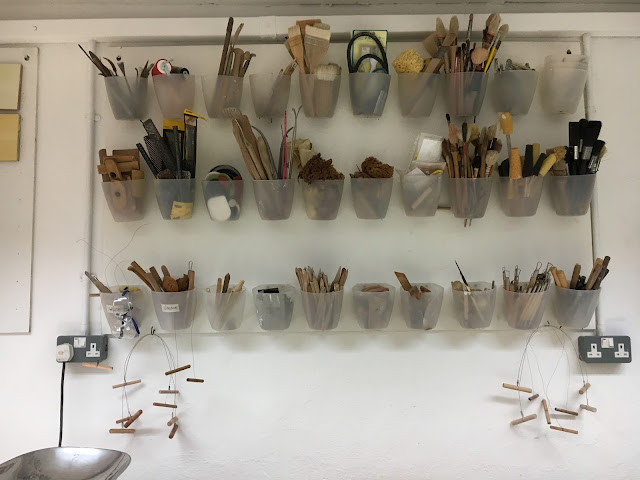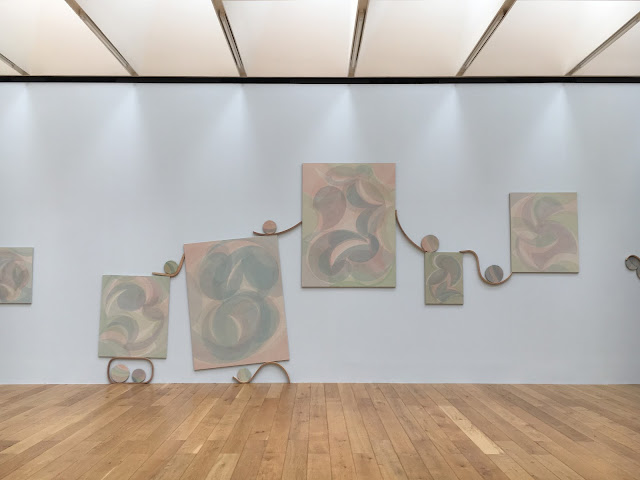Our second day actually took us out of Amsterdam to Utrecht. It was the only pre-planned day of activities, as Hannah especially wanted to take us to see the Shröder House (which I didn't know about at all, but I LOVED once I got there). Basically, we can credit Andrew Graham Dixon's 'Art of the Low Countries' for our day trip an hour out of Amsterdam. Thank you BBC 4.
In the Stedelijk Museum the previous day, we saw this little model of the house with another mocked up room by Rietveld in the space, so it gave me a little taste of what I was going to see. It shared a room with Sandberg's posters, which gave me a sense of the dynamic of the Dutch art and design world at the time. It turned out that Rietveld and de Stijl happened to be working on the same aesthetic around the same time, and on discovering each other, Rietveld was embraced as an artist and designer rather than as a local furniture maker.

The house is only open through a guided tour, which we had thankfully booked in advance... otherwise we wouldn't have been able to see inside! The Shröder House was commissioned by Truus Shröder-Shräder, a Dutch socialite who married a lawyer, Fritz Shröder. The lived in a very large, luxurious apartment in Utrecht, but the couple had very different ideas about lifestyle, social status, and from the sounds of it, the material things within that space. Fritz introduced Rietveld to Truus, and let her change one of the rooms in the apartment to the way she wanted it; Rietveld built the infrastructure, of which one element was building in a lower ceiling. While her friends saw the room as very plain she loved the simplicity of it, and thus Truus and Rietveld's partnership began.
In 1924, as a widow in her mid 30s with a teenage son and two pre-teen daughters, she sought a new place to live with her children. She wanted more space, some peace and quiet, and a view of nature. She commissioned Rietveld for the task as architect, but she had a very clear vision of what she wanted. She wanted open space, big windows, and a connection between the inside and outside. They found a piece of land on the outskirts of Utrecht, a plot that they described in an interview as 'a place truck drivers went to piss' at the end of a row of terraced houses. But the benefit of this plot was the land beyond it, which was a lovely field. Neither Truus or Rietveld had had much serious training in architecture, but with Rietveld's knowledge of furniture-making, they sought to create something completely radical.
The front door opens into a square porch with a door to the left and right, a door in front, and set of painted grey square steps to the second floor. The floor of the room is painted blue. There is no longer any objects (except for a few pieces of furniture) in the house, but once accustomed to the primary colours, smaller details become apparent; the different hooks for adults and children's coats; the clear glass post box; the tan leather strap on the back of the bench on the top square step, for leaning on as you use the phone. It was interesting to experience all these textures together. It felt all at once humble and sort of chaotically put together, and yet a lot of fun and ingeniously practical.
The rest of the downstairs was made up of a simple kitchen, a 'maid's' room which never had a maid in it, Rietveld's studio, and a cosy study room. It very quickly became apparent that Truus and Rietveld were not just partners in work, but also eventually became lovers, in spite of Rietveld's wife and family. The best room on the ground floor was the study room, which had a black painted ceiling for bringing in the space, and lots of inbuilt furniture. It had two fold out tables, painted yellow and grey, and several benches and chairs to sit on, and best of all LOTS of shelving for lots of books.
The upstairs however, was the real star of the show. Up the grey square steps and a very narrow black spiral staircase, the room opened up to the whole floorplan of the house flooded with the light. Where downstairs was divided, upstairs was completely open, with a view outside from all four sides of the house. the floor was marked out by different colours to signify each room, and could be cleverly enclosed at night or for privacy using several sliding doors, painted black and grey. In a space the the left of the stairs was a room for the two daughters. Their area was painted blue, with two beds in a L shape in the corner. They have their own balcony and bookshelf, and the room was displayed with one of Rietveld's famous tables. Next to their area was the oldest son's room, painted red. His room was larger, to accommodate his baby grand piano which today is replaced with one of Rietveld's Red and Blue chairs, with a large window facing out towards the view. Next to his room was the largest space in the upstairs, a dining and living area which encompassed a whole corner of the house. The most fascinating part was the huge windows that could open completely at the corner, thanks to a very clever 'L' window. One of the gallery assistants opened up the window, and enclosed some of the sliding doors to get a sense of how the space worked, and I could imagine how the house was constantly active and dynamically used. Opposite the room for the girls was the bathroom and Truus' bedroom, which also had it's small details. She had a tiny black drop down table for her alarm clock, and a very thin red shelf next to her bed for her glasses. Built into the cupboards was a sink, and next door in the bathroom was a lovely deep stone bath, a beautiful contrasting material to the glossy consistency of the coloured paint.

Particularly after our trip to the Tugendhat Villa in Brno, it made me think a lot about the role of the architect, but also their agenda. At the Tugendhat Villa, especially with the details that Magdalena shared about the house, you got the sense that the collaboration was very one-sided, towards the desires and influence of Mies Van der Rohe rather than the needs of the family. While the house is absolutely stunning, to me it never felt lived in, luxurious rather than warm and loved. The materials of the house and the furniture themselves felt precious, untouchable and actually kind of discomforting in concept - in some ways it felt a little bit sick. I absolutely loved it and loathed the concept of it at the same time. MVdR, probably tainted by the week, did not come across as a very nice guy at all. Not that that was the point, but it's interesting to find a person beyond the famous name.
The Shröder House on the other hand, in its materiality conveys the complete opposite, even though it is on paper the same kind of object. Both houses are commissioning famous designers/architects from Modernist movements, working at around the same time, commissioned by elite women as a new or second home. Both are situated in already established neighbourhoods, and are local anomalies to be stared at and noticed. Both buildings aimed to be a statement. But somehow, there is something about the Shröder House that makes it completely different to the Tugendhat Villa, which certainly makes the Rietveld seem like a totally different kind of person the Mies.
Ultimately the Shröder House seems to be built, in some ways, for love. It feels like its built with enthusiasm and spontaneity, for the needs of a moment which ended up defining how one used the house. It feels like it grew and changed over time, adding pieces here and there when the idea came, and it sounded like Truus had the ultimate say on how it looked and felt. Pieces like the leather strap on the bench in the porch, feel like a practical lightbulb moment. It was a house that the teenage children was embarrassed by, but then proud of later on in life. In spite of it being an empty showroom, like the Tugendhat Villa is as well, it feels like someone lived there for several decades, which of course Truus lived in until she died in 1985. In that way, the Shröder House is more convincing as a defiant statement of a way of life for a widowed woman and her children, opposite to the decadence of the old Art Nouveau, and the new glamour of Modernism expressed by architects like MVdR.
When a plot of land opposite the house opened for sale, Truus bought the land for Rietveld to pursue his real dream - designing social housing. Today these still exist, but now as a school and studios. Tragically, a viaduct and motorway was built right next to the Shröder House before Truus' death in the 1980s. She remarks in the same interview that she thought at the time it should have been knocked down, that it is no longer the same house without the view. But what I can appreciate in its restoration is the real spectrum of design and architecture that was happening in this period, despite the umbrella term of Modernism, and without the house, I'm not sure you can really tell from individual pieces of furniture in museum collections. While I am no expert, and probably will never be as knowledgeable as some of my friends and tutors are on this period in central European design, I love seeing and experiencing it as an observer of their everyday lives and relationships. While it was all radical, it was real and heartfelt by passionate people.
My last thought, which Hannah and I discussed at breakfast the next day, is how important the role of women are in the process of iconic buildings. Both Lilly Reich and Truus Shröder-Schräder were clearly essential to the identity of both houses, and both women it seems, created for the love of their work and in partnership with people they loved. It's a shame that these women get pushed under the water while names like Mies Van der Rohe and Rietveld overshadow their contribution. I keep trying to find books about Lilly Reich, and come out of libraries empty-handed. It just goes to show that it's still, several decades later, an enormous problem that needs solving by the new generations of design historians by getting past the rhetoric and looking for the details.

















































